
Firemen peer into the nave of Notre Dame toward end of yesterday’s fire.
Notre Dame lives!
Monday was pure concentrated stress and sadness – the horror! – watching the spire teeter and fall, then seeing the fire creep along what remained of the roof toward the betowered west façade, and then, as flames attacked its south tower, hearing the French interior ministry prepare us for the horrid possibility that 400 “pompiers” might somehow fail, after stouthearted hours of battle, to save Our Lady of Paris.
At last, checking news updates on the way to bed, I learned that the fire was under control, and that damage might be far less than would naturally be imagined from the evidence of one’s own eyes that had tortured us all day.
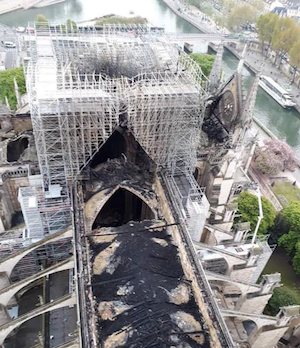
View of damage to ceiling, whose strength, buttressed by the medieval technical innovation of rib vaulting, protected the nave below from debris of roof and spire.
This was confirmed the next morning, and throughout the day. Miraculously saved, it appeared, were the rose windows of stained glass, the crown of thorns, the 18th-century organ, many great works of art, even the copper rooster atop the fallen spire, which was found in the rubble below. Surviving were the exterior walls braced by flying buttresses, the interior walls of the nave are intact, and many of the pews, sconces and chandeliers were protected from debris from the burning roof and falling spire by the nave’s ceiling, most of which seems to have held fast, doubtless strengthened by its rib vaulting, a 12th-century innovation whose effectiveness has now been proved in a literal trial by fire.
I visited Notre Dame in the fall of 2002 and, gripping my broke-back Penguin edition of The Hunchback of Notre Dame, mounted to the highest public viewing platform. I will not be able to bring my wife, Victoria, and our 10-year-old son, Billy, to the same spot, or anywhere near it, if we visit this summer. I cannot tell whether the tragedy is pushing me toward or pulling me away from the trip. Atop the depredations of modern architecture since my last trip to Paris – such as the ridiculous renovation along the rue de Rivoli, near the Louvre, of the historic Samaritaine department store – a thick sadness hangs over Paris. The vandals are already inside the gates. This weighs heavily in our balance of visitation, largely dominated until yesterday’s fire by the cost of air fare.
Yes, the damage is horrendous even if it is mainly confined to the lost spire and roof. Water pumped by pompiers can harm stone structures – that story awaits. The cause of the fire remains unknown but is presumed accidental, possibly ignited by renovation work on the spire. An investigation is under way. Reconstruction is sure to take years, and yet contributions of €1 billion have already been made by wealthy French businessmen and others. The University of Notre Dame, in South Bend, Ind., has donated $100,000. Paris appears to have dodged the bullet that struck Glasgow – twice, when a fire that burned Charles Rennie Mackintosh’s art school (1896-1909) in 2014 was followed in 2018 by an even more devastating fire that is forcing an almost entire reconstruction of the lost building.
The project to reconstruct the Glasgow School of Art was harried by the theory that only a modernist replacement could honor the creative spirit of Mackintosh. At least there can be no doubt, I told myself this morning, that a rebuilt Notre Dame will replicate the roof, spire and other features as they were. But now I hear that a French architect has proposed a “Bundestag option” – a reference to the modernist dome by Sir Norman Foster plopped onto the German parliament restored to its otherwise original appearance many decades after it was set ablaze in 1933 by Hitler, when it was known as the Reichstag. The fire served as a pretext for the Nazis to suppress dissent in the period following Hitler’s rise to power.
Can we trust that cooler heads will prevail in Paris? I hope so. Rebuilding Notre Dame recalls the rebuilding of Dresden’s Frauenkirche and, closer to home, the proposal to rebuild New York’s Penn Station, as it was designed by Charles Follen McKim, half a century after its demolition in 1963-66. As Peter Van Erp, of Providence, put it in a comment below about the granddaddy of restorations: “When the 1514 Campanile of St. Marks in Venice collapsed in 1902, the immediate reaction of the people was: ‘Com’era, dov’era,’ or ‘How it was, where it was.’ We should all cry out: ‘Comment c’était, où c’était!'”
But France, like most of Europe and the European diaspora in the rest of the West, is deeply sunk in attitudes that reject tradition and embrace anti-tradition, and especially a fierce anti-clerical sentiment, not just in church architecture but in almost every type of belief and field of endeavor. Maybe, however, there is something profound to be read into what drove Parisians watching the blaze to sing hymns together and pray aloud in public. Maybe, just maybe the atavistic sorrow unleashed by yesterday’s tragedy will cause Parisians, and others equally moved, to take a deeper look into their souls.
An essay I read this morning by classical scholar Wes Callihan seemed to express that hope in the form of regret:
When a tragedy happens quickly, we notice and are rightly shocked. When it happens slowly, those who even notice at all are mocked or ignored. We’ve all seen the pictures in the news by now of the bare ruined choirs where late the sweet birds sang in the interior of Notre Dame. That charred, smoking mess we see is our civilization as it has been for the last 200 years. We do not live in Old Western Culture, not even in the twilight of it. We live in the cold, charred ruins. We ought to grieve, with real tears, over the sudden demise of Our Lady of Paris. But we ought likewise to be grieving every bit as much over the long, slow, agonizing demise of the culture she watched over protectively and then sadly for so long.
Or, as Churchill put it in his 1943 reply to those who would rebuild in some novel fashion the bombed-out House of Commons chamber in Britain’s parliament building: “We shape our buildings; thereafter, they shape us.”
Architecture is the canary in the mineshaft. It is dead. When it died is a detail that can be debated, but the point remains. Maybe, in the aftermath of yesterday’s tragedy, the canary can be reborn.
(Update: France’s prime minister has announced an international design competition to determine whether to rebuild the spire as it was or not at all, or as “adapted to techniques and challenges of our times.”)
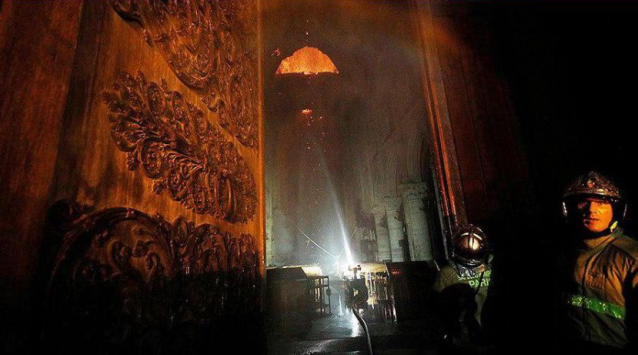
View into nave during fire, whose orange blaze may be seen through what looks like an arched space left from a section of vaulting high in background where the spire fell through.
Two sets of before-and-after shots show Notre Dame’s interior (ABC News):
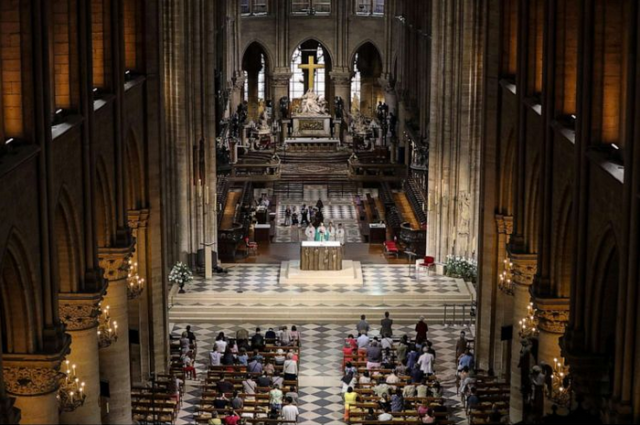
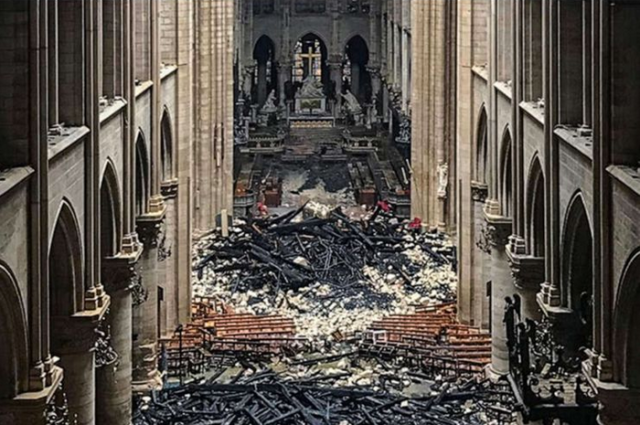
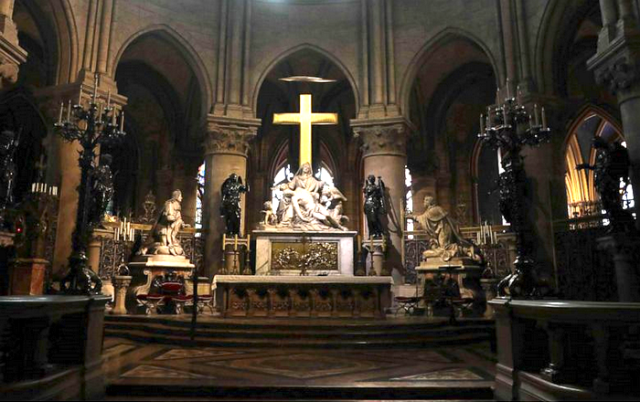
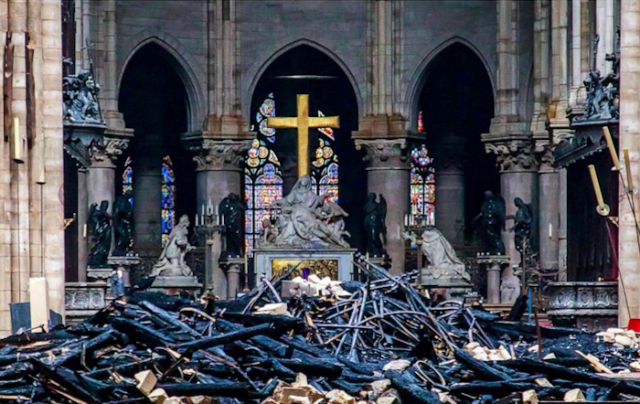



What you are looking at, when looking at the Notre Dame, is a former religious symbol of power, of ‘I crush you’ power, equivalent (in that respect) to the modernist and neo-modernist non religious corporate forms of contemporary times. Now, Americans, of all people, many of your ancestors fled from the dictatorship, persecutions, prosecution, torture and top down control of European Christianity.. so what are you decrying.. and what for..
Now of course, this is the ideological side, but also architecturally these structures seen as a whole are bizarre, absurdist, overdone, grotesque, labyrinthine…
Living near Ghent in Belgium, it’s not that I do not value these Gothic buildings, but one should be aware of the dark past of which they are a product of.
What is missing in the second photo below, is a symbolic beam of sunlight, finally reaching into a place without it:
LikeLike
I’m not sure I can embrace your dark vision that seems to blame cathedrals for the dark acts of the religions that built them. I think most people who venerate the architecture are aware of Catholicism’s dark episodes. But I don’t think those can be blamed on the buildings. Modernists take that tack, not reasonable people. Notre Dame exhibits none of the qualities (“bizarre, absurdist, overdone, grotesque, labyrinthine”) that you seem to see. Far from it.
LikeLike
Well said, David. I hope this sad event can awaken the masses to the general decline of tradition and contextualism in the broader built environment. Social acquiescence to modernist historicism and architectonic bling is troubling, particularly at the upper reaches, where the arts-educated -the privileged- should know better.
LikeLike
Fabulous tribute David. And the comments I can read are mostly appropriate. What I fear is, probably like you, the request by Pres. Macron for international architects to submit proposals, which will inevitably lead to suggestions like a Peirymid, or a TransAmerica spire.. NPR today had someone who said for speeds sake forget recreating the oak roof frame, and I could accept that, I guess. Personally, I was texting with my sister, remembering that our family spent Easter weekend in 1969 in Paris, with my Dad taking pictures of all of us posing with gargoyles! And I visited again in 1972, trying my best to get photos of the rose windows. Have to dig out the old slides, digitize them and send to her.
LikeLike
Your thinking pretty much reflects my own here, William. I don’t mind modern materials and techniques so much as some determination to make the spire take on a different and even a contrary appearance to its traditional look. Replicating a roof framing of wood may be impossible given the unavailability of the proper trees, and, most important, unlike the spire, the average visitor can never see the roof support system anyway. I have my own great shots from my 2002 trip, which I have digitized, and glad I did.
LikeLike
David,
Appreciated your wise observations about our shared culture, and your concluding note of optimism. Maybe this near loss, will awaken the French, and all of us, to the destruction that Western culture has been undergoing for decades. As Joni Mitchell put in Paved Paradise, “Don’t it always seem to be, that you don’t know what you got till it’s gone.” Pardon the Canadian (?) dialect.
LikeLike
Thanks you, Milton. As for Joni Mitchell’s lines, I used them to open Chapter 3 in my book Lost Providence, about the demolition of the Providence National Bank building (which has not been rebuilt, alas, and remains a parking lot, albeit elegantly fronted by the elegant remaining facade of the demolished building.
LikeLike
When the 1514 Campanile of St. Marks in Venice collapsed in 1902, the immediate reaction of the people was: “Com’era, dov’era.” “How it was, where it was”.
We should all cry out: “Comment c’était, où c’était!”
LikeLike
Damn right, Peter, and I’m going to put that into my piece.
LikeLike
WITHOUT COMMENT.
I’m reporting what the Italian architect Massimiliano Fuksas, who designed the Church of the Apostle Paul at Foligno, Italy, proposes for the reconstruction.
“I’m thinking of the correct balance between the extremely contemporary, and recovering parts of the ancient structure… I don’t think it’s going to be a lantern [like I built on top of the Military Union Building in Rome], but the first idea that comes to mind, for example, is a sort of very high pinnacle made like a Baccarat crystal, which is French, and which can be illuminated at night and filled with light.”
Best regards,
Nikos
LikeLiked by 2 people
No comment required, Nikos.
LikeLike
Reblogged this on LeveVeg and commented:
Sitatet av Wes Callihan gikk rett i hjertet på meg, og slik støtte gjør uendelig godt. Selv lever jeg i den første av himmelengene, Mjøslandets høylys, og føler det på akkurat samme vis når jeg ser opp til Holmstadengen, hvor bygningene ligger lik to sorgtunge øyne og ser utover landskapet de voktet så stolt, men nå så sorgtungt. Grenda mi blomstret opp under husmannstroen, som ikke kun var en tro, men en kultur, av de fremste allmenninger Norge har sett. I enga mi lever vi nå i de kalde, forkullede ruinene av mine forfedres mesterverk. Fordi jeg sørger over tapet av engene og husmannstroen, hånes og ignoreres jeg, ikke kun av Anti-Dahl og totiban, men selv av engenes og husmannstroens barn. For de ser ikke det langsomme forfallet, de ser ikke deres forakt for husmannstroen, og kaller sitt forfall for framskritt.
LikeLike
Thank you so much, Leveveg. I wish I could read the comment. Can you send a translation? By the way, I have slightly recast the paragraph in my post leading into the quote from Wes Callihan, in case you’d like to update it in your own post.
LikeLiked by 1 person
Thanks! Holmstadengen Farm on the top of the Lake Mjøsa Land reminds me of sorrowful eyes looking over this fallen land and the abandoned culture that flourished here: https://commons.wikimedia.org/wiki/File:Holmstadengen_morgenr%C3%B8dme.jpg
Here lived a preacher, son of a released “husmann” or serf, like most small farmers were here up to the Totenåsen Hills, slaves for the big farmers down by Lake Mjøsa. After they were released from their chains, this preacher came here and created a very strong kind of layman Christianity, in opposition to the State Church the big farmers belonged to, and these released serfs created strong bonds around the Totenåsen Hills, building their own prayer houses, making their own songbooks, having their own preachers and music teams. Now all gone, except for one prayer house in Northern Hurdal, where this preacher, M.J. Dahl, first arrived in the last part of the 1800s.
I try to photograph this farm where Dahl lived as his farm falls down. And nobody in the Lake Mjøsa Land anymore care about his message and the strong, viable “Husmanns”-culture he created among these poor farmers and former “husmanns”-slaves.
LikeLike
Love the photo! An architect’s reaction https://savedbydesign.wordpress.com/2019/04/16/rebuilding-a-tabernacle-notre-dame/
LikeLike
Which photo, Duo? I’ve also added several more since you commented. The photo from the air showing how much of the vaulted ceiling remains intact has attracted a lot of interest among readers.
Very moving tribute in your post, Duo. As you surely know by now, France has proposed an international design competition to rebuild the spire. It would be interesting to know the answer to the question raised in your post in reference to “rely[ing] on what we create to manifest what we will be.” So with regard to the spire, how should it be rebuilt to manifest what we will be?
LikeLike
It is a repair, but $1B eggs on the Egotists to make it an opportunity: IF the competition is open to reinvention, I would beg those who do restoration (not me) to FLOOD the competition with 100’s of ways to get the perfect reconstruction done in the best way possible: I would ask the schools to enter with a design course focus on remaking the spire in inventive ways totally unseen when done: Maya Lin was a student…(I loved the drone shot)
LikeLike
Not clear exactly what you mean, Duo. Specifically, are you urging entrants in the contest to produce “perfect reconstruction in the best way possible” – which sounds like you want to see the spire rebuilt to look as it did before – or “remaking the spire in inventive ways totally unseen when done,” which sounds like it could be a pure replication in which the techniques and materials might be inventive, or the reverse, that the designs are not replication but are themselves inventive (but then how could they be unseen when done?).
Am interested in your view, Duo, but this comment is hard to decipher.
LikeLike
I also thought “HUH?” to both of Duo’s comments. I wouldn’t, I think, be righteously offended by sort-of recreating the spire in a different material-crystal, stainless, or another shiny metal. Just don’t offend M. Violette-le-Duc’s (SP?) ghost.
LikeLike
Just seeing your response, IF we get a Blue Sky Competition to spend a $Billion, it would be instructive to those judging to see any number of entries than describe repair, methods and outcomes, to go alongside the ice skating rinks, Lazarus, greenhouses and zeppelin docking ports that will no doubt be Submitted…
LikeLike